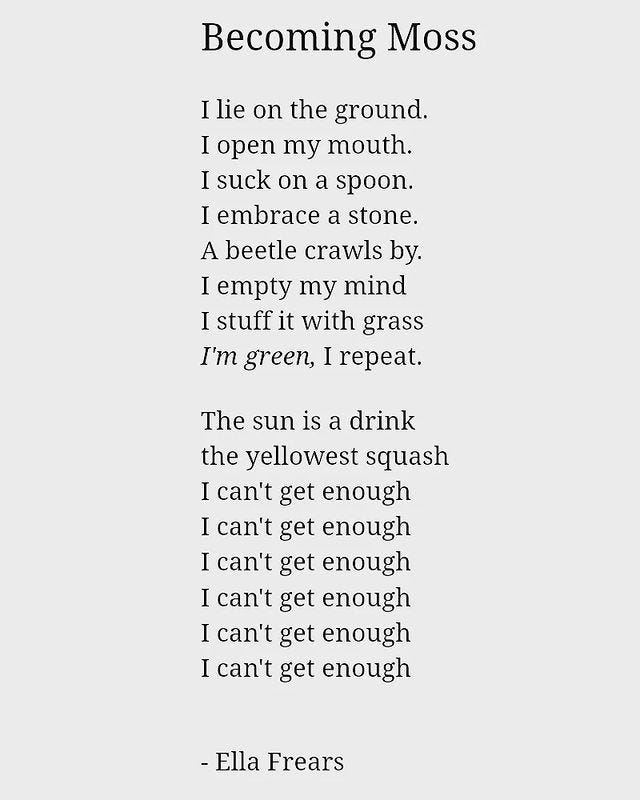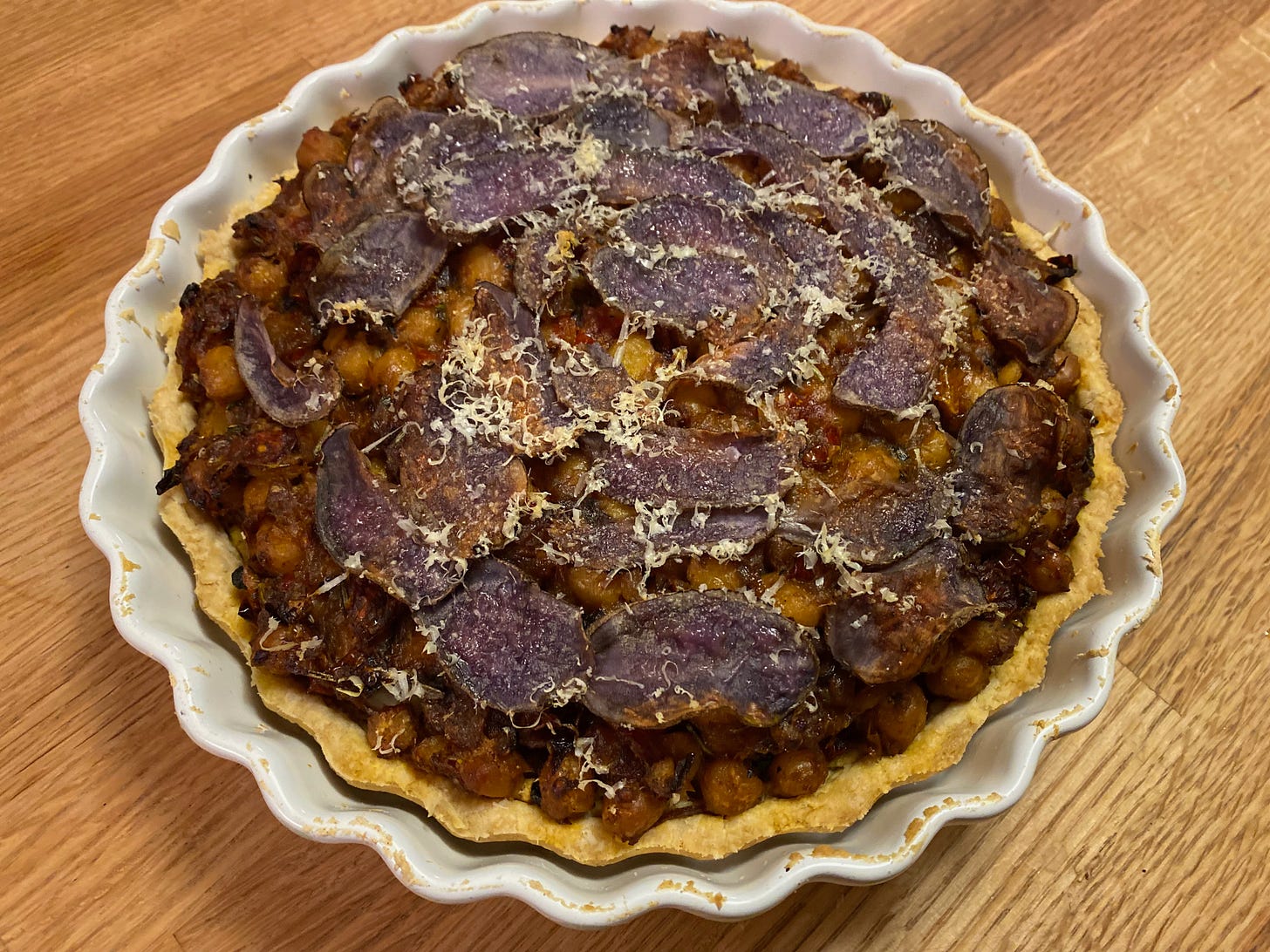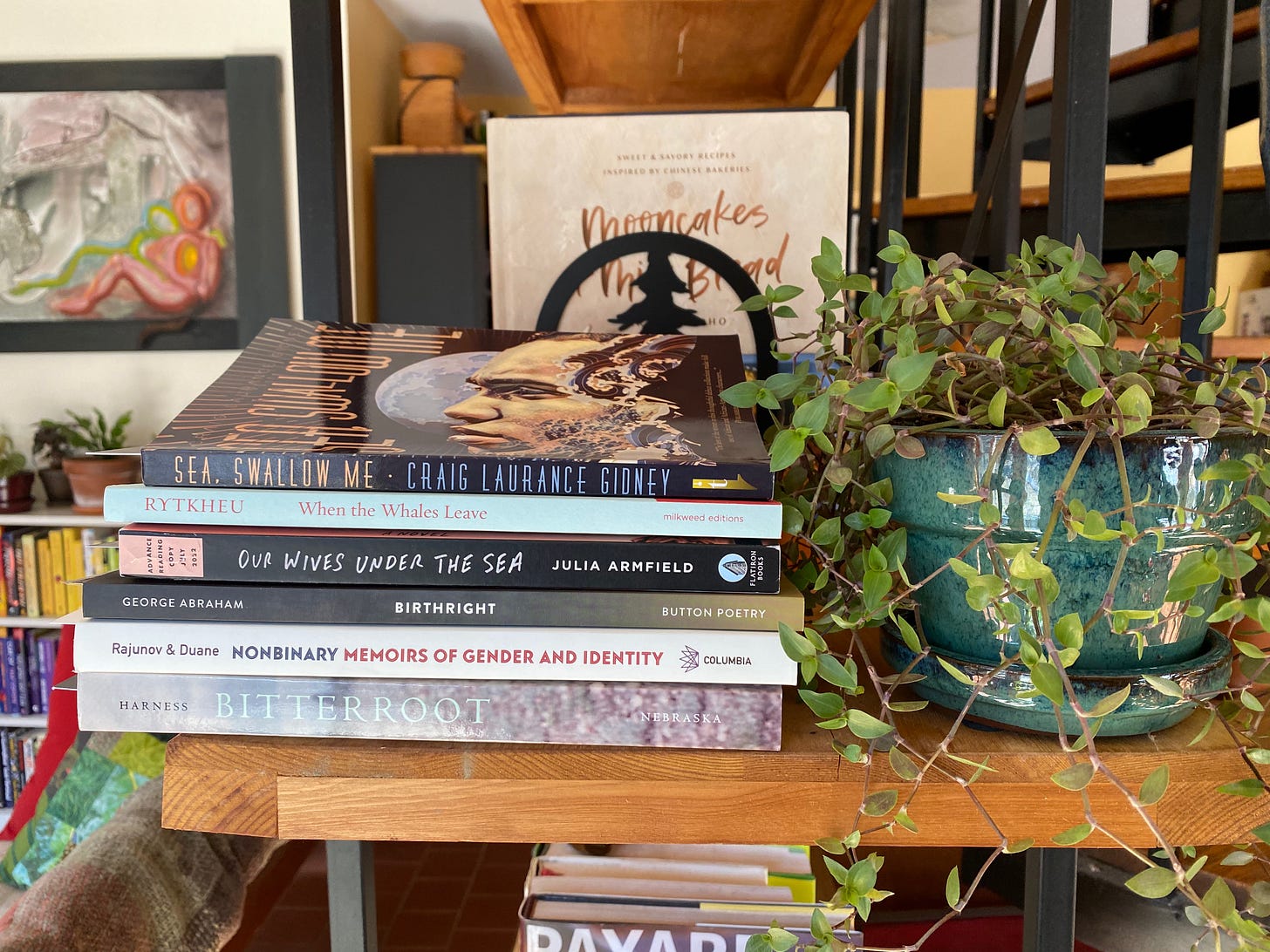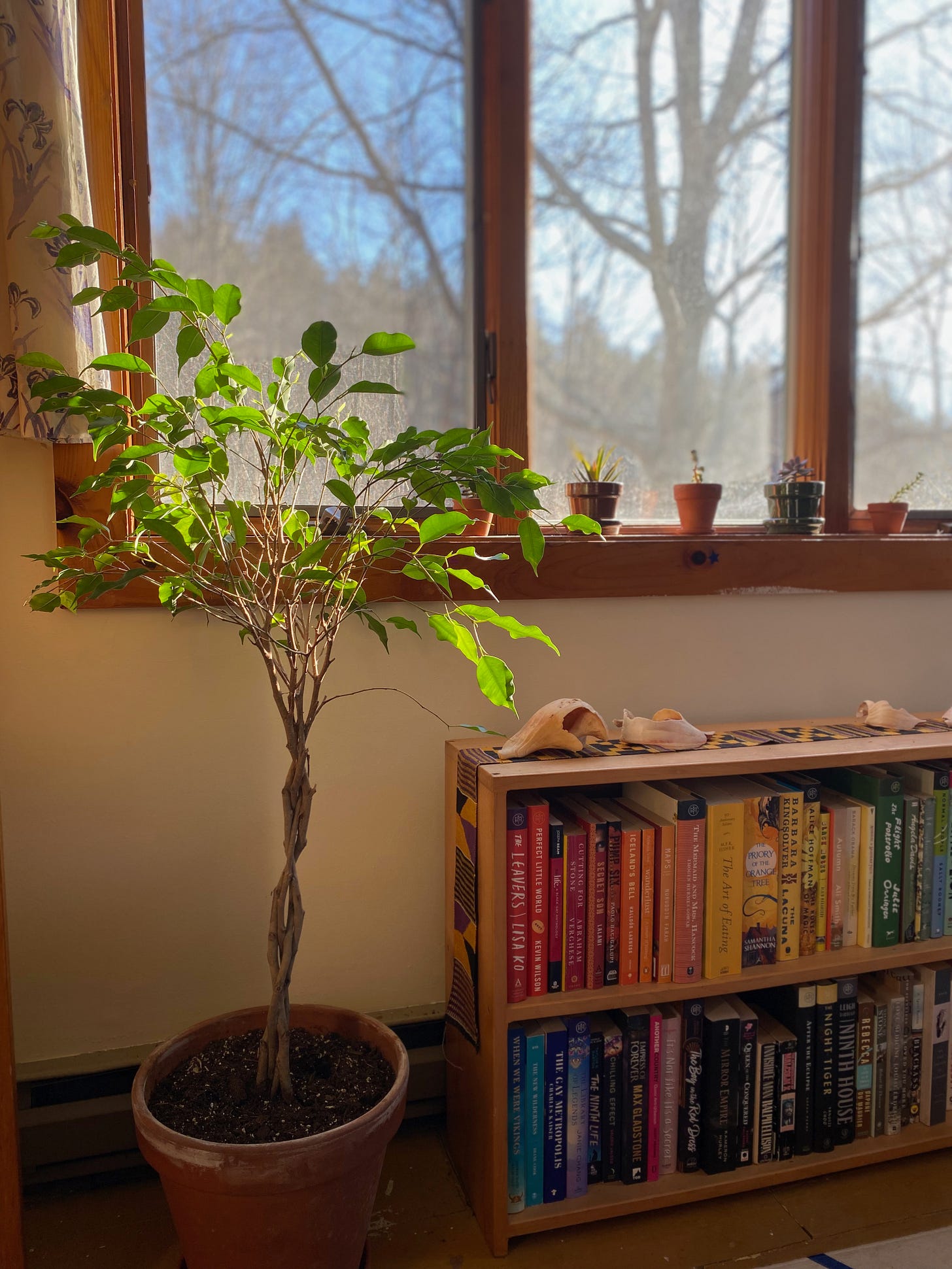Volume 2, No. 7: Circles, Loops, & Spirals + Chickpea & Potato Tart
Greetings, book and treat people! I am so happy to be reading again! Let’s talk about books! But first, this poem, which stopped me in my tracks when I saw it:
I had a lot of trouble deciding how to frame this week’s theme. It’s not that these books are non-linear, exactly. It’s that they loop back and forth in time, tangling and untangling themselves. They are full of messy threads: past, present, and future weaving in and out and back and forth and up and down. They circle and loop and spiral, never staying in the same place for long.
The Books
Backlist: Notable Native People by Adrienne Keene (Nonfiction, 2021)
This gorgeous books is a straightforward collection of beautiful drawings of 50 Indigenous people, as well as short profiles about each one. At first glance, it’s not a book that plays with time in any meaningful way. Its innovative structure is not its most memorable quality. But it is absolutely a book that loops through time, a book concerned with the complicated interplay between past, present, and future.
In the introduction, Keene writes:
Growing up, the lesson I learned in school about Indigenous people was that we were people who existed only in the historical past, that we and our cultures were extinct and had no connection to the present day. I never learned about any Native people over that historical male leaders like Sitting Bull and Geronimo, and I was surrounded by images in popular culture of harmful stereotypes. But this narrative of Native people couldn’t be more wrong. We are not extinct, and there are so many important Katie people of the past and today whose stories and lives have resonance, power, and are worth learning about.
The erasure Keene writes about is still prevalent—it’s the same lesson I was taught in school: that colonization was a thing that happened once upon a time, that it ended, and Native people ended with it. Of course there is nothing even remotely truthful in any of that. Colonization is ongoing. Indigenous peoples and cultures are ongoing.
The fifty people profiled in this book are only fifty out of many. They represent, as Keene explains, “the three broad cultural groups of American Indian, Alaska Native, and Kānaka Maoli”. Their stories are not arranged chronologically, but in a beautiful non-linear mess. Lili’uokalani (1838-1917), the last queen of the Hawaiian Kingdom, appears next to Princess Daazhraii Johnson, a filmmaker and activist born in 1974. These Indigenous activists, artists, culture keepers, writers, scientists, politicians, athletes, farmers, engineers, leaders, and performers are of the past, the present, and the future. Keene features people from many generations, and while the focus is on contemporary figures, the inclusion of some historical figures—including many lesser-known people you may not have heard of—provides continuity.
I read this book in one weekend, drinking in the stunning drawings and one-page profiles. It’s accessible and engaging, and one I know I’ll be revisiting. Interspersed between the profiles are short essays about colonization, language, geography, representation, and history. Notable Native People is an introductory text, but it’s not a shallow one. It’s a doorway into the Indigenous past, a celebration of the Indigenous present, and an invitation into the Indigenous future.
I don’t usually read with my phone nearby, but I made an exception for this book, so that I could look up some of the people profiled to learn more about their work. Here’s just a small taste of a few of the people featured (the descriptors after the names come from the book):
Rowen White, Seed Keeper (@rowenwhite): If you’re unfamiliar with her work and words, get ready to experience some deep beauty and do some deep thinking.
Geo Soctomah Neptune, Basketmaker & Drag Artist (@niskapisuwin): THere’s a lot of amazing stuff here, including stunning baskets.
Joshua Lanakilaoka’āinaikapono Mangauil, Activist & Culture Keeper (@lanakilamangauil): If you want to learn more about Hawaiian activism, check out Lanakila’s work.
Jihan Gearon, Environmental Justice Organizer & Activist (@jihangearon): Activism and art!
Keene also mentions Indigenous Goddess Gang’s weekly feature Matriarch Monday, which highlights a different Indigenous woman every Monday. I highly recommend checking it out.
Frontlist: Fiona and Jane by Jean Chen Ho (Fiction)
This is a beautiful, quiet, episodic book about two Taiwanese American women and their lifelong friendship. I’ve seen it descried as both a short story collection and a novel. I’m honestly not sure how it’s being marketed, but to me it felt decidedly novelistic. It’s a book of stories, but the stories converse with each other and build on each other. Fiona and Jane each have their own arc that pushes the book forward, even when it’s not necessarily moving forward in time. Jane’s concerns the death of her father, a loss that haunts every page of the novel, even—especially—when Jane herself is avoiding it. Fiona’s arc is mostly concerned with class and career: her drive to achieve finical stability and a career that’s easily legible as “successful”.
I love the looseness of time in this book: it moves back and forth a lot, not only between Jane and Fiona’s POVs, but between times and places. It’s not a linear book. As Fiona and Jane grow up, grow apart, come back together, and grow apart, Ho revisits various important pieces of their lives: their childhoods, their relationships with their families, their careers, their romantic entailments. Sometimes a scene unfolds first from Jane’s perspective, and then, later, from Fiona’s or vice-versa. Often, the two women’s internal musings about their childhood are contradictory. They remember things differently. A slight or a fight, one particular night at a party or driving around LA—all of these instances affect Fiona and Jane in surprising, lasting ways that don't always line up. They don’t always see each other clearly.
While Ho delves into all sorts of themes—queerness, familial expectation, the experiences of first and second generation immigrants, the millennial grind—at heart, this is a book about a friendship. But as is so often the case with lifelong friendships, Fiona and Jane’s relationship, though central to the book, is not always at the center of their lives. That’s what makes the episodic nature of this story so brilliant. It’s the perfect way to write about a friendship like this, one that ebbs and flows but never vanishes. Though Fiona and Jane grow up together, they spend a large portion of their adult lives living on opposite coasts. I have had close friendships with people who have been geographically distant over the years, and this book feels so true to that experience.
Fiona and Jane go through periods closeness and periods of distance. They let small hurts grow into bigger ones, and sometimes those hurts grow into misunderstandings or resentments, but more often, over years, they simply disappear. At times, the women are deeply focused on each other; at other times, they are focused on their own lives. Sometimes they are there for each other and sometimes they’re not. They come back to each other changed, and sometimes they feel familiar to each other, sometimes foreign. What a simple, truthful way to write about a lifelong friendship.
Upcoming: The Immortal King Rao by Vauhini Vara (Speculative Fiction, W.W. Norton, May 3rd)
This book is so many things; it’s almost dizzying, in fact, how many stories and ideas Vara threads together. But in essence it’s a compelling alternate history and eerily plausible imagined future of the internet, and of the mega tech corporations that have shaped the internet.
It’s divided into three distinct timelines, although they often blur together; they are not as separate as they seem. One story takes place in a small village in rural India in the 1950s. King Rao, who will go on to become the most powerful man in the world, grows up among cousins, uncles, and aunts on his Dalit family’s coconut plantation. Then there’s the story of King’s arrival in the US for graduate school in the 1970s, and his invention of the device that will change the world forever, the personal computer, known as the Coconut. Finally, there’s the story of King’s daughter, Athena, at some date in the near future, deep into the age known as “Hothouse Earth”, the world’s nations now ruled by a single, all-powerful Board of Directors. Athena, imprisoned for the murder of her father, recounts the series of events that led to her arrest.
This is a sprawling epic, at once historical and dystopian and current. It’s satirical (the Coconut Corporation is a kind of Google/Apple hybrid, unstoppable and ruthless), but it’s not really funny. Or, if it is, it’s that painful kind of funny, the unflinching kind that forces you to look at the world—its flaws, its absurdity, its atrocities—even when you'd really rather not. Vara’s imagination is so bright and vivid. Everything about the worlds she draws feels exact. The future she envisions is terrifying and disturbingly plausible: capitalism has run (even more) rampant, people are known only as Shareholders, and a computer Algorithm controls all interactions. But the pasts she imagines are equally compelling. The whole novel, from the technological innovations described to the complicated web of relationships that defines the daily lives of one Dalit family in 1950s India, is overflowing with life and truth. I trusted the world of this novel absolutely, and that made it a pleasure to read.
But for all its thematic acrobatics, it’s mostly a book about human relationships. Athena, the narrator of the whole novel, has been gifted her father’s memories through his last invention, a kind of brain-internet linkup. As she rifles through them, she comes to know him differently, and thus comes to know herself differently. All of the big stuff that happens—and a lot happens, this novel sometimes reads like a history—is grounded in the intimate connections between people. It’s a book about betrayal and longing, romantic and familial love, the frayed bonds between estranged lovers, between parents and children who can’t quite see each other. It’s about all the tiny moments that define our lives and the relationships that fuel our actions.
At one point, musing on the nature of beauty, Athena marvels at how incredible it is “that, despite everything, we go on opening and opening and opening ourselves to one another.” To me, this book feels like one long opening, a reckoning with the stories we tell ourselves about each other and the world. It’s often sad and brutal, but it is also filled with hope and beauty. There is gentleness in it, and fierce truth-telling.
The stories of our lives are ephemeral; when we die, they die, too. But what if someone (what if I) could gather up these stories and hold on to them for safekeeping? When humans finally drive ourselves to extinction, wouldn’t that be our best shot at proving to the universe that, once upon a time, we were here?
It’s out May 3rd, and you can preorder it here.
The Bake
This is one of those recipes where I just kept adding things, and it kept getting better. I wanted a savory tart, so I made some dough. I caramelized some onions, always a good filling. Then I remembered I had some cooked chickpeas in my fridge, and thought, why not? And why not some thinly sliced potatoes on top? And why not throw in some dried tomatoes? And why not a spicy mustard-garlic spread on the bottom? Why not?
Chickpea, Onion, & Potato Tart
This recipe has a lot of components, so it does take some time. But the wonderful complexity of all the flavors is so worth it!
Ingredients
For the crust:
2 sticks (16 Tbs/227 grams) cold unsalted butter, cut into small pieces
240 grams (2 cups) all-purpose flour
pinch of salt
2-4 Tbs ice water
For the filling:
3 Tbs butter
3-4 red onions
1-2 tsp rosemary, fresh or dried
4 small potatoes
1 can chickpeas, drained
1/4 cup dried tomatoes or sun-dried tomatoes packed in oil
1/2 cup Parmesan cheese, grated, plus extra for the top
1 Tbs mustard
3 Tbs soft goat cheese
1 garlic clove, minced or pressed
1 Tbs olive oil
Make the crust: Put some cold water in a bowl with ice and set aside. In a mixing bowl, combine the flour, salt, and butter with your fingertips. To keep the dough from getting too warm, dip your fingers in the ice water every now and then. Mix until it resembles coarse sand (some larger chunks of butter are okay). Add the water a little bit at time, mixing with your fingertips between each addition. When the dough mostly holds together, dump it on the counter and knead it a few times to gather into a ball. Flatten into a disk, wrap with plastic wrap, and stick it in the fridge. (You can do the mixing in a food processor.) (You also don’t have to chill it. This dough is so forgiving; I’ve rolled it out hundreds of times without chilling.)
Blind bake the crust: On a lightly floured surface, roll out the dough into a 12-14” circle. You want it to be fairly thin, but don't worry about it too much. Drape it over a 10” tart pan and gently mold the dough into shape, making sure to press gently into the creases along the edges. Trim the excess, but leave about 1” of overhang. Prick the bottom all over with a fork.
Butter the shiny side of a piece of aluminum foil and press it over the dough. Line with pie weights, dried beans, or rice. Bake at 400 for 30-35 minutes, until golden. Let cool completely on a wire rack. Trim the excess to create an even top.
Make the filling: Preheat the oven to 400. Thinly slice the onions. Heat the butter in a medium saucepan and add the onions, cooking on medium low heat until beautifully caramelized, about 30 minutes. Add the rosemary and salt and pepper to taste. Set aside.
Thinly slice the potatoes into rounds and arrange them in a single layer on a baking sheet. Drizzle with a little olive oil and use your fingers or a brush to spread it around. Bake for 10-15 minutes. The potatoes should be soft, but not too browned. Set aside. Leave the oven on.
If you’re using dried tomatoes, rehydrate them in boiling water for 5 minutes, then drain. If you’re using sun-dried tomatoes, drain them. Either way, finely chop them. Add the dried tomatoes, chickpeas, and Parmesan to the onions and mix well. Set aside.
In a small bowl, combine the mustard, goat cheese, garlic, and olive oil. Mix well and set aside.
Assemble the tart: Spread the mustard-garlic mixture evenly over the bottom of the cooled tart shell. Next arrange a layer of sliced potatoes in overlapping circles. Pile on the onion-chickpea mixture and smooth it with a rubber spatula. Arrange the rest of the potatoes on top. Sprinkle extra grated Parmesan over everything. Bake for 30-40 minutes, until the potatoes are nicely browned. Let cool slightly before serving.
The Bowl and The Beat
The Bowl: Cheesy, Meaty Pasta Bake
This is my ultimate comfort meal: meaty tomato sauce, cheese, pasta. It doesn’t take that long to make, and more importantly, it doesn’t feel like it takes that long to make. It is an emotionally easy meal to prepare. It’s the sort of basic, filling warmth I crave when I’m extremely hangry.
Thinly slice an onion or two and sauté in olive oil until it begins to soften. Add as much pressed garlic as you like. I often use a whole head. Continue cooking until the onions begin to caramelize. Add a jar of whole or crushed tomatoes or tomato puree (this passata is my absolute favorite), salt and pepper, and some dried oregano or thyme if you feel like it. Add a pound of ground meat (any kind!), and let the sauce simmer until thickened. Meanwhile, cook your favorite pasta, drain, and set aside. Thick pastas like rigatoni or penne work well.
Preheat the oven to 350. In a large Dutch oven or casserole dish, combine the sauce, pasta, and a whole lot of grated Parmesan. I had some smoked mozzarella sitting around, so I tossed in small chunks of that as well. Mix thoroughly. In a separate bowl, combine 3/4 cup or so bread crumbs (I used panko, whatever you have is fine), some extra parmesan, a pinch of salt and pepper, and any fresh herbs you like. Spread this over the top of the dish, and add some pats of butter, too. Bake for ~30 minutes, until golden and melty and perfect.
The Beat: Delilah Green Doesn’t Care by Ashley Herring Blake, read by Kristen DiMercurio
It is such a joy to be listening to audiobooks again! I missed them so much during my week of no reading—much more than reading print books. I just started this queer romance and I’m into it! Family drama, a bisexual bookstore owner who’s also a single mom, a queer photographer who’s also a total mess, small town shenanigans. We’ll see if it ends up being angsty enough for me, but so far I’m enjoying it a lot. The narration is great, too.
The Bookshelf
The Visual
After my week of not reading, I spent all of last weekend jumping up and down about books. I am just! So excited! About them! Here’s the stack I’m working my way through this week. I am pretty pumped about all of them so far.
Around the Internet
On Book Riot, I wrote about meeting books where they are. I rounded up ten queer books from indie presses you don’t want to miss this year. I wrote about the books I think have shaped me vs. the one book that has actually shaped me. And I got vulnerable about dating and queer romance novels.
Now Out
Hurray! The Swimmers by Julie Otsuka is now out. I simply cannot explain how much I love this book. It’s a masterpiece. You can read my review for BookPage here. Coincidently, it is also a book filled with loops and circles and unexpected spirals!
Bonus Recs about Circles, Loops & Spirals
If you haven’t read it yet, there’s the absolute brilliance that is In the Dream House. And Split Tooth by Tanya Tagaq is another amazing book that loops and spirals and unfolds in dizzyingly nonlinear ways.
The Boost
I haven’t written here about the all the censorship and book bans happening right now. It’s an organized, well-funded, and ruthless attack, and it’s horrifying. Kelly Jensen at Book Riot has been covering it extensively; you can read all the current censorship news here. She also put together a tool kit for fighting book bans and challenges. The Stacks recently did a 5-part podcast series taking to authors, educators, students, librarians, and others about the book bans, and what folks can do about it. I highly recommend listening.
As always, a little bit of beauty to send you on your way: It’s been warm enough to work upstairs in my office the past few days, and I am so grateful for the space, the light, the quiet.
And that’s it until next week. Catch you then!










